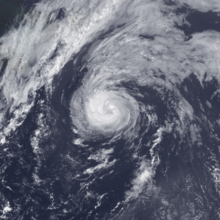 Arlene at peak intensity in the North Atlantic Ocean on August 22 | |
| Meteorological history | |
|---|---|
| Formed | August 10, 1987 |
| Dissipated | August 23, 1987 |
| Category 1 hurricane | |
| 1-minute sustained (SSHWS/NWS) | |
| Highest winds | 75 mph (120 km/h) |
| Lowest pressure | 987 mbar (hPa); 29.15 inHg |
| Overall effects | |
| Fatalities | None |
| Damage | $8,000 (1987 USD) |
| Areas affected | Bahamas, Bermuda, Spain, Italy |
| IBTrACS | |
Part of the 1987 Atlantic hurricane season | |
Hurricane Arlene was a long-lived tropical cyclone that moved eastward in an erratic fashion in the northern Atlantic Ocean in mid-August 1987. The first named storm of the 1987 Atlantic hurricane season, Arlene formed out of an area of low pressure associated with a decaying frontal system along the North Carolina coastline, Arlene tracked in a general eastward direction across the Atlantic Ocean, taking an erratic track with several curves. On August 13, the storm brushed Bermuda as a weak tropical storm before continuing out to sea. On August 20, the storm briefly stalled before becoming a hurricane two days later. Early on August 24, the storm transitioned into an extratropical cyclone over the far north Atlantic before curving southeast and dissipating near the Iberian Peninsula on August 26.
In Bermuda, Arlene produced winds up to 58 mph (93 km/h) and waves up to 12 ft (3.7 m); however, little damage resulted from the storm. Offshore, a blind man was undertaking a challenge to become the first blind man to cross the Atlantic alone; he encountered rough seas and high winds from the storm, causing US$8,000 in damages to his ship over a two-day span. Between August 26 and 27, the remnants of the system produced heavy rains over portions of Western Europe.
